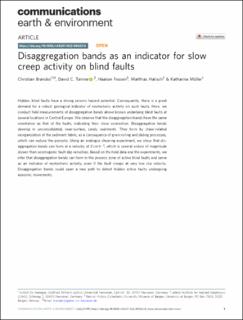| dc.contributor.author | Brandes, Christian | |
| dc.contributor.author | Tanner, David C. | |
| dc.contributor.author | Fossen, Haakon | |
| dc.contributor.author | Halisch, Matthias | |
| dc.contributor.author | Müller, Katharina | |
| dc.date.accessioned | 2022-10-26T09:48:43Z | |
| dc.date.available | 2022-10-26T09:48:43Z | |
| dc.date.created | 2022-05-14T13:03:50Z | |
| dc.date.issued | 2022 | |
| dc.identifier.issn | 2662-4435 | |
| dc.identifier.uri | https://hdl.handle.net/11250/3028373 | |
| dc.description.abstract | Hidden, blind faults have a strong seismic hazard potential. Consequently, there is a great demand for a robust geological indicator of neotectonic activity on such faults. Here, we conduct field measurements of disaggregation bands above known underlying blind faults at several locations in Central Europe. We observe that the disaggregation bands have the same orientation as that of the faults, indicating their close connection. Disaggregation bands develop in unconsolidated, near-surface, sandy sediments. They form by shear-related reorganization of the sediment fabric, as a consequence of grain rolling and sliding processes, which can reduce the porosity. Using an analogue shearing experiment, we show that disaggregation bands can form at a velocity of 2 cm h−1, which is several orders of magnitude slower than seismogenic fault-slip velocities. Based on the field data and the experiments, we infer that disaggregation bands can form in the process zone of active blind faults and serve as an indicator of neotectonic activity, even if the fault creeps at very low slip velocity. Disaggregation bands could open a new path to detect hidden active faults undergoing aseismic movements. | en_US |
| dc.language.iso | eng | en_US |
| dc.publisher | Springer Nature | en_US |
| dc.rights | Navngivelse 4.0 Internasjonal | * |
| dc.rights.uri | http://creativecommons.org/licenses/by/4.0/deed.no | * |
| dc.title | Disaggregation bands as an indicator for slow creep activity on blind faults | en_US |
| dc.type | Journal article | en_US |
| dc.type | Peer reviewed | en_US |
| dc.description.version | publishedVersion | en_US |
| dc.rights.holder | Copyright 2022 the authors | en_US |
| dc.source.articlenumber | 99 | en_US |
| cristin.ispublished | true | |
| cristin.fulltext | original | |
| cristin.qualitycode | 1 | |
| dc.identifier.doi | 10.1038/s43247-022-00423-8 | |
| dc.identifier.cristin | 2024586 | |
| dc.source.journal | Communications Earth & Environment | en_US |
| dc.identifier.citation | Communications Earth & Environment. 2022, 3, 99. | en_US |
| dc.source.volume | 3 | en_US |

